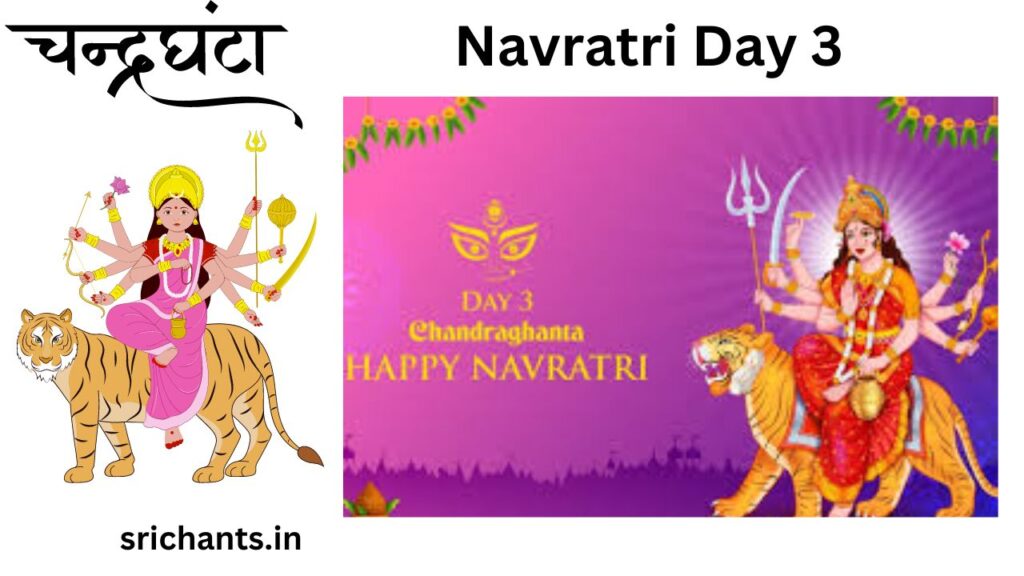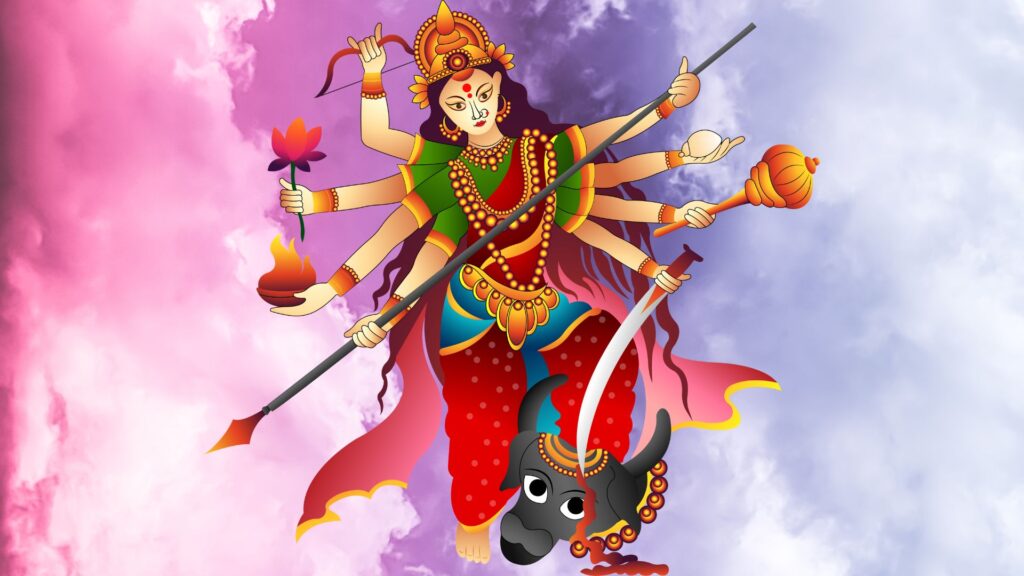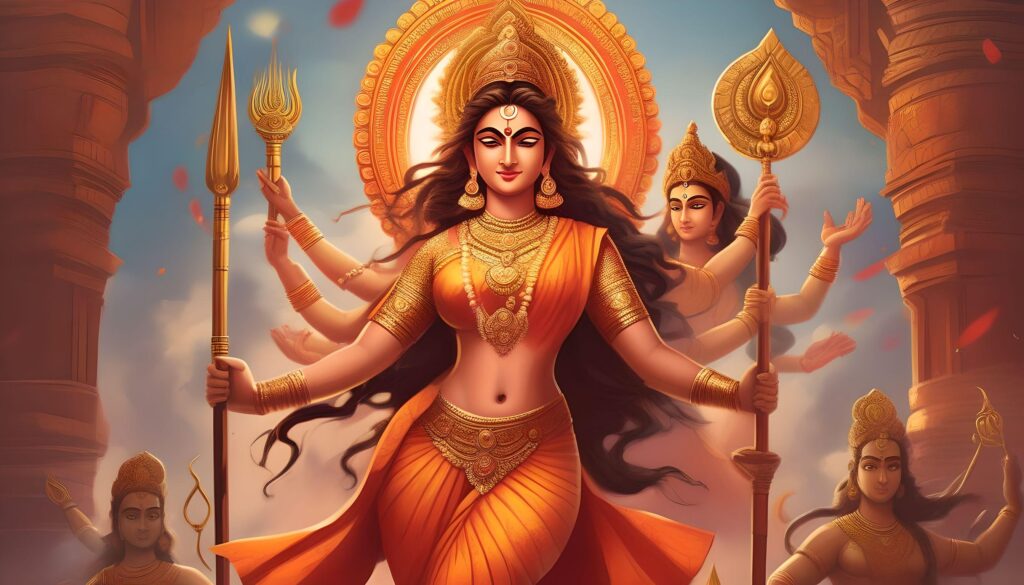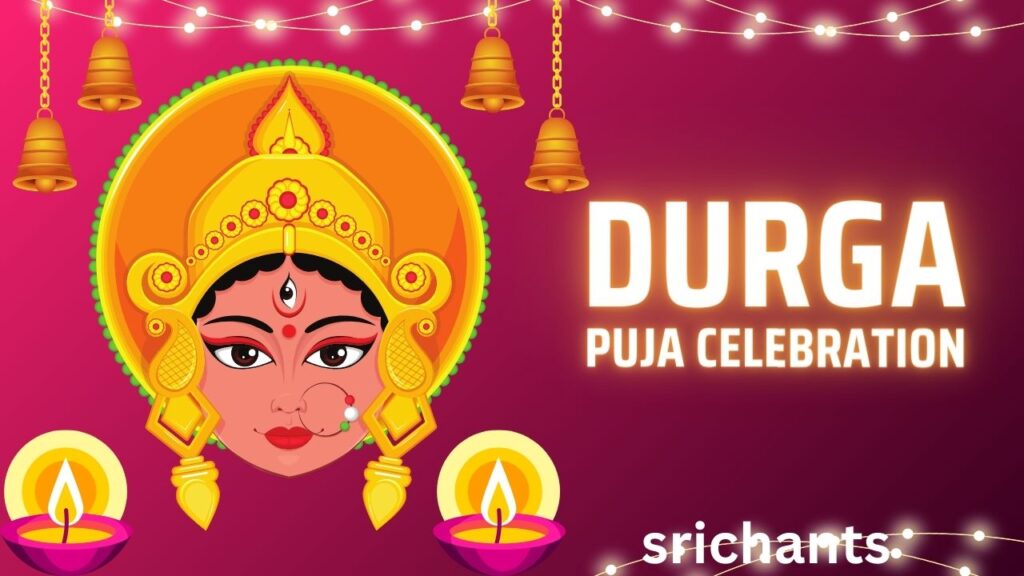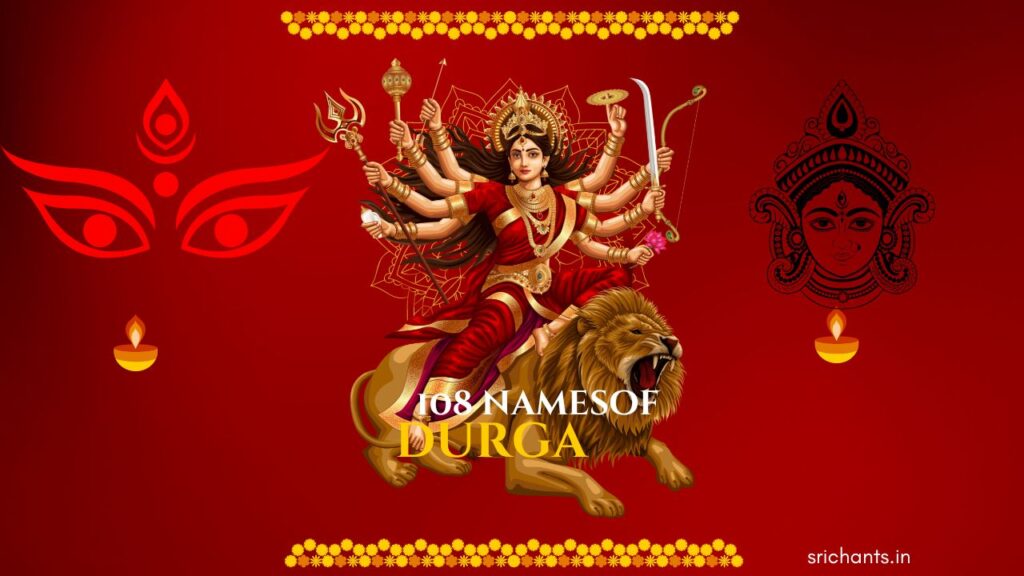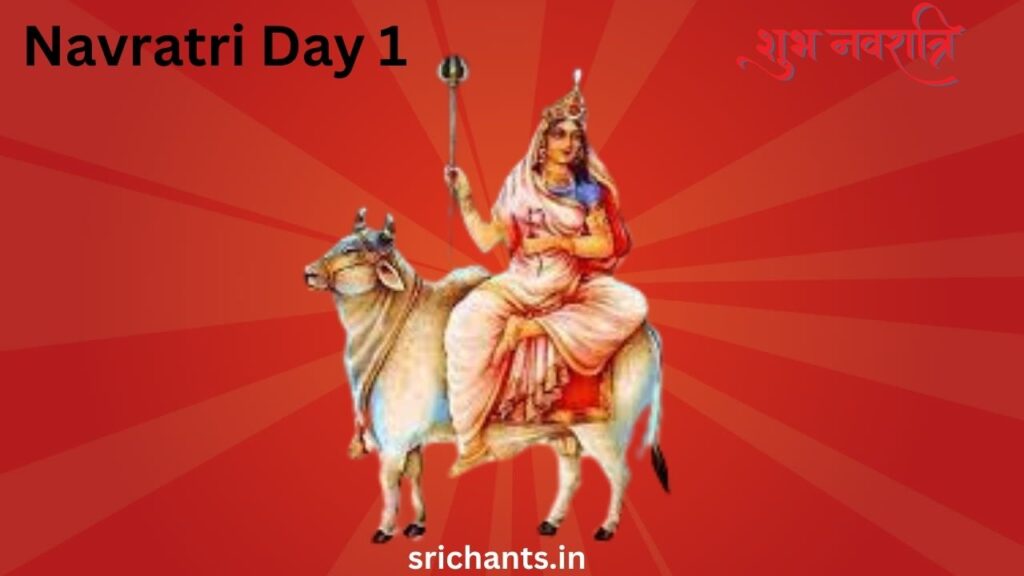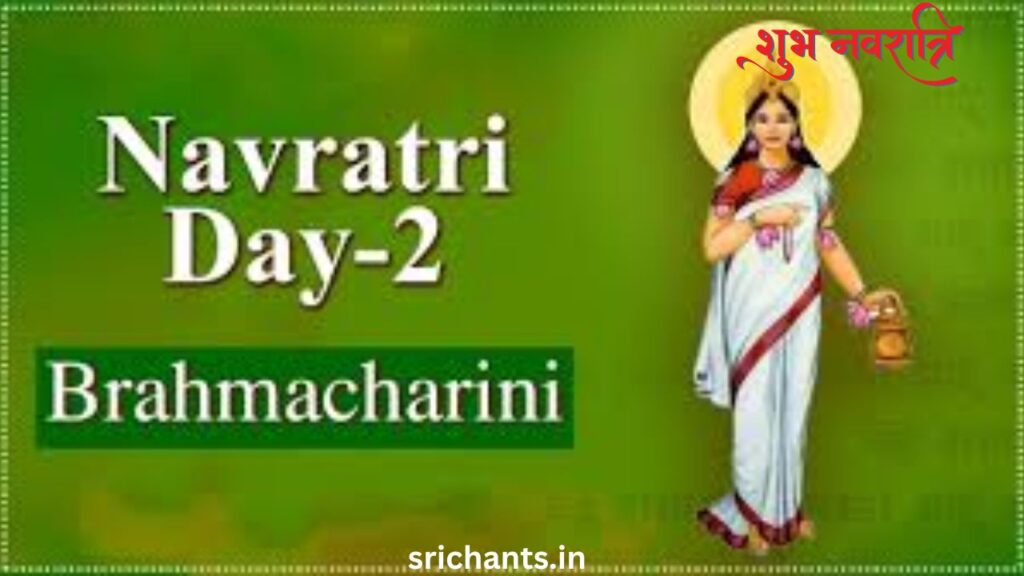Navratri Day 3: Chandraghanta -Unveiling the Serene Power of Goddess
Introduction
Navratri, the nine-night festival that is observed throughout India, is a period of profound spiritual awakening and reverence for the sacred feminine. This auspicious celebration is dedicated to a distinct manifestation of the Goddess, each with its own distinctive symbolism and significance, on each day. Devotees convene on the third day of Navratri to pay tribute to the Goddess Chandraghanta, who is known for her courage and tranquility.
Chandraghanta, the married avatar of Goddess Parvati, is a captivating figure that exemplifies the duality of strength and grace. Her name, which translates to “the one with a bell-shaped crescent moon on her forehead,” represents her capacity to dispel negativity and establish a sense of harmony and tranquility. The deeper layers of wisdom and inspiration that this revered form of the Goddess offers are revealed as we explore the rich tapestry of Chandraghanta’s legend and the rituals associated with her devotion.
The Legendary Origins of Goddess Chandraghanta
The narrative of Chandraghanta is profoundly rooted in the ancient Hindu scriptures and the eternal love story between Goddess Parvati and Lord Shiva. Parvati, the daughter of the formidable deity Daksha, was initially referred to as Sati. She underwent rigorous penance in order to earn Shiva’s affection and become his consort, as a result of her profound devotion and unwavering love for him.
Nevertheless, the union of Parvati and Shiva was not without its obstacles. Parvati was profoundly offended when her father, Daksha, failed to invite Shiva to a grand yagna (sacrificial ritual). Shiva was plunged into a state of profound grief and rage as a result of Parvati’s self-immolation in the sacrificial fire, as she was unable to endure the insult to her adored husband.
Shiva initiated the Tandava, a cosmic dance of devastation, in response to his anguish, with the intention of annihilating the entire universe. In order to reestablish equilibrium and safeguard the world, the gods enlisted the assistance of Parvati, who subsequently assumed the form of Chandraghanta, a fierce and courageous warrior deity who rode a majestic tiger and was adorned with a crescent moon-shaped bell on her forehead.
The Symbolism and Attributes of Goddess Chandraghanta
Chandraghanta is a captivating figure who embodies the duality of the divine feminine. She is both graceful and unyielding, serene and ferocious, a testament to the Goddess’s multifaceted nature. The symbols she caries and her distinctive appearance are of profound spiritual significance.
The Crescent Moon-Shaped Bell
The crescent moon-shaped bell that adorns Chandraghanta’s forehead is a potent symbol. It symbolizes her capacity to eliminate darkness, negativity, and malevolent influences. It is believed that the bell’s resonating sound has the capacity to dispel demonic entities and restore peace and harmony.
The Tiger Mount
Chandraghanta is frequently depicted riding a majestic tiger, which serves as a representation of her unyielding determination, fortitude, and strength. The Goddess’s capacity to confront and overcome any obstacles that may arise is symbolized by the tiger, a formidable predator.
The Ten Hands
Chandraghanta is depicted with ten hands, each of which is grasping a distinct sacred object or weapon. Her multifaceted powers and her role as the protector of her devotees are symbolized by these symbolic items, including the lotus, trident, bow and arrow, and rosary.
The Mudras
The Abhaya Mudra, a gesture of reassurance and protection, is raised by the Goddess’s right hand, while the Varada Mudra, a gesture of favors and the fulfillment of desires, is held by her left hand. Chandraghanta’s intention to impart her grace and protect her devotees is illustrated by these mudras, or hand gestures.
The Significance of Worshipping Goddess Chandraghanta
Devotees attach profound spiritual significance to the worship of Goddess Chandraghanta on the third day of Navratri. In the Hindu pantheon, she is a revered and potent figure due to the legends that surround her and her distinctive attributes.
Overcoming Adversity and Fear
Chandraghanta is renowned for her unwavering fortitude and her capacity to confront and overcome evil. Devotees endeavor to foster a similar spirit of courage and resilience by honoring her on this day, thereby enabling them to confront the obstacles of life with grace and fortitude.
Restoring Balance and Harmony
The narrative of Chandraghanta’s intervention to restore equilibrium in the universe and pacify the raging Shiva is a testament to her role as a peacekeeper. It is believed that worshiping her will result in a sense of harmony, both within the individual and in the broader cosmic order.
Spiritual Growth and Transformation
The third day of Navratri, which is dedicated to Chandraghanta, is a period of spiritual introspection and development. Devotees can embark on a transformative voyage of spiritual awakening and self-discovery by reflecting on the Goddess’s attributes and aligning their own energies with her serene yet courageous nature.
Protection and Blessings
Chandraghanta is regarded as a protective Goddess who can protect her devotees from malevolent forces, negativity, and injury. It is believed that seeking her blessings will result in a sense of security, well-being, and the fulfillment of one’s desires.
Rituals and Practices for Worshipping Goddess Chandraghanta
A complex tapestry of spiritual practices and rituals dedicated to Goddess Chandraghanta is observed on the third day of Navratri. Not only are these observances rooted in tradition, but they also facilitate a deeper connection with the divine feminine.
Morning Rituals
Devotees typically commence the day with a purification ritual, which includes the wearing of clean, preferably white or light-colored, clothing and a purifying bath. Subsequently, they established a sacred altar that contained the image or idol of Chandraghanta, as well as other deities and sacred objects. Mantra recitation, including “Om Devi Chandraghantayai Namah,” is a prevalent practice during this period.
Offerings and Decorations
Devotees present the Goddess with a diverse array of offerings, such as milk, fresh flowers (particularly jasmine or marigold), incense, and the illumination of a Diya (lamp). It is believed that these offerings are intended to appease the Goddess and elicit her blessings.
Meditation and Contemplation
Devotees concentrate on the qualities and attributes of Goddess Chandraghanta during the day, engaging in meditative practices. Additionally, they may dedicate time to introspection, considering the importance of the third day of Navratri and the ways in which the Goddess’s teachings can serve as a source of inspiration in their personal lives.
Fasting and Dietary Restrictions
On the third day of Navratri, a significant number of devotees observe partial or complete fasts, abstaining from specific foods and indulgences as a method of spiritual purification. The diet that is generally recommended is “sattvic,” which emphasizes the consumption of wholesome and vegetarian foods.
Evening Rituals
The Aarti, a ritual that involves the chanting of devotional songs and hymns and the offering of light in honor of Goddess Chandraghanta, is performed by devotees as the day draws to a close. Satsangs, which are community gatherings where devotees convene to engage in spiritual discourse and collective prayer, are also prevalent during this period.
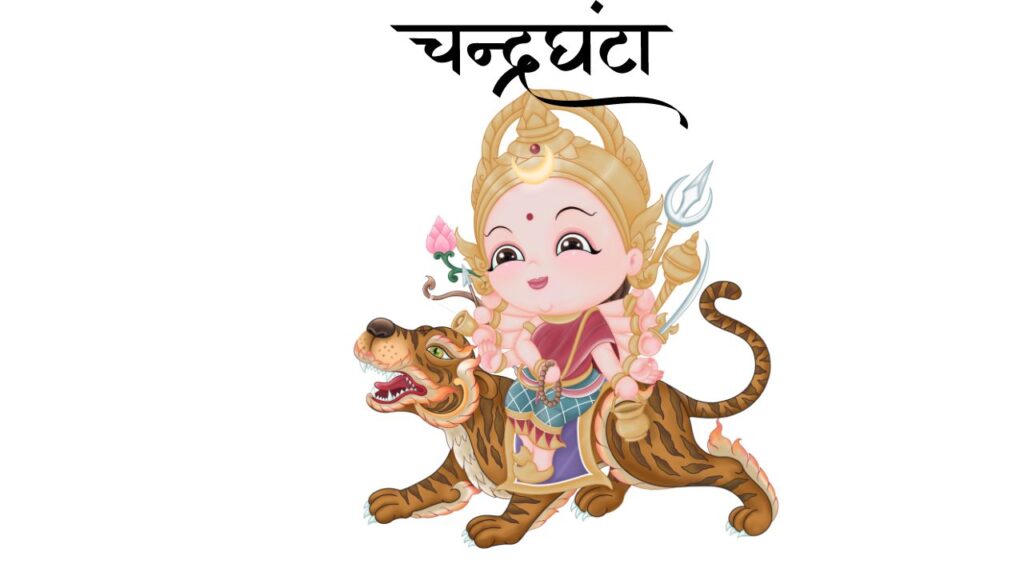
The Significance of the Tritiya Tithi (Third Day)
The Tritiya Tithi, or the third day of Navratri, is of particular importance in the overall commemoration of this auspicious festival. It is on this day that the emphasis is shifted to the worship of Goddess Chandraghanta, a manifestation of the divine feminine that embodies the qualities of serenity, grace, and courage.
Courage and Fearlessness
Chandraghanta’s character of unwavering determination and bravery is cultivated during the Tritiya Tithi. Devotees endeavor to confront challenges, surmount their fears, and adopt a life of fearlessness and resilience by paying tribute to the Goddess on this day.
Spiritual Awakening and Growth
Navratri is a period of spiritual introspection and transformation in its entirety. The third day, which is dedicated to Chandraghanta, is a critical juncture in this voyage, motivating devotees to further explore their spiritual practices and align their energies with the Goddess’s serene yet powerful nature.
Harmony and Balance
The Goddess’s function as a peacekeeper is emphasized by the narrative of Chandraghanta’s intervention to restore equilibrium in the universe following Shiva’s destructive dance. The Tritiya Tithi is an opportunity to foster harmony in one’s relationships, environment, and self.
Protection and Blessings
On the third day, devotees seek the blessings and protection of Goddess Chandraghanta, supposing that her grace can protect them from malevolent forces, negativity, and injury. This day is regarded as a chance to secure the Goddess’s favor and invoke her benevolence for the benefit of oneself and one’s loved ones.
The Symbolic Colors and Offerings of Chandraghanta Day
The third day of Navratri, which is specifically dedicated to the Goddess Chandraghanta, is associated with specific colors and offerings that possess profound symbolic significance.
The Color Grey
Grey is the color that is associated with the Tritiya Tithi, and it is believed to symbolize the equilibrium between light and darkness, the coexistence of the gentle and the ferocious. In honor of the Goddess’s dual nature, devotees frequently don grey-colored attire or decorate her image with grey flowers.
Floral Offerings
The third day of Navratri is no exception to the special significance of flowers in Hindu rituals. Devotees frequently present blossoms to Goddess Chandraghanta, including marigold and jasmine, as they are believed to be particularly appealing to her.
Milk and Kheer
Milk and a unique sweet delicacy known as Kheer, a rice pudding, are frequently presented to the Goddess as part of the ritual offerings. Kheer is a symbol of the sweetness and abundance that the Goddess can impart upon her devotees, while milk is regarded as a pure and nourishing substance.
The Spiritual Benefits of Worshipping Goddess Chandraghanta
Devotees can experience a plethora of spiritual advantages by participating in the worship and veneration of Goddess Chandraghanta during the Navratri festival.
Cultivating Courage and Resilience
Devotees can cultivate a stronger sense of inner strength and the capacity to confront life’s obstacles with fortitude by aligning themselves with the Goddess’s unwavering courage and determination.
Achieving Harmony and Balance
The Goddess’s role in restoring balance and harmony in the universe can motivate devotees to pursue a similar equilibrium in their own lives, thereby cultivating a sense of serenity and well-being.
Spiritual Transformation and Awakening
Devotees may embark on a journey of self-discovery and a heightened awareness of the divine within by engaging in profound spiritual transformation through the deep contemplation and meditation of Chandraghanta’s attributes.
Protection and Fulfillment of Desires
It is believed that seeking the blessings and grace of Goddess Chandraghanta will provide devotees with a sense of security, protection, and the fulfillment of their sincere aspirations.
Conclusion
The third day of Navratri is a profound and transformative experience for devotees, as they venerate Goddess Chandraghanta. The duality of grace and strength is embodied by this serene yet courageous manifestation of the divine feminine, which motivates us to achieve a comparable equilibrium within ourselves.
The deeper layers of wisdom and inspiration that this revered Goddess offers can be unlocked by exploring the rich symbolism and legends associated with Chandraghanta. Her narrative serves as a reminder of the significance of confronting adversity with fortitude, reestablishing harmony in our lives, and embarking on a voyage of spiritual development and self-discovery.
May the blessings of protection, resilience, and the fulfillment of our deepest desires of Goddess Chandraghanta guide us toward a life of balance, serenity, and inner transformation as we honor her during this auspicious time.
navratriday3 #navaratriday3 #chandraghantadevi #day3navratri #day3navratrigoddess #chandraghanta #maachandraghanta #3rddayofnavratri

